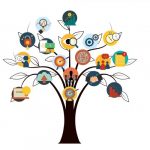Diversity, Equity, and Inclusion (DEI). If “DEI” or any of the variations – EDI or DIE – were a brand, the marketing lead would be fired for developing and launching a mixed message marketing campaign with dangerously false advertising. The DEI “brand” is deeply misunderstood, and the words are used uncritically and interchangeably.
As a practitioner in the space, I find this frustrating. Too often, companies don’t take the time to understand the words, their meanings, and how they relate, before they move forward on their DEI journey. I firmly believe that change will accelerate if we build a common language and understanding for these critical conversations.
If your team is considering how to move forward with your DEI journey, take some time to align on these concepts. If you do, I promise you it will be much easier to design the right strategies around them.
Defining diversity
People are not diverse, but teams and companies must be.
Let us clear something up: A person is not “diverse,” and there’s no such thing as a “diverse” candidate. Referring to a person as “diverse” would only make sense if we were all the same, but we’re not. Referring to a person as “diverse” is increasingly used as code for people who belong to groups considered non-dominant, or those with historically less privilege.
Identities such as man, white or light-skinned, heterosexual, cisgender, able-bodied, English-speaking, and educated, as examples, are considered dominant or privileged groups. Identities that deviate from these, such as woman, racialized or dark-skinned, queer, transgender, or disabled, for example, are often considered non-dominant or are less privileged groups.
For example, when we say that someone who is transgender is “diverse,” we implicitly imply that a cisgender person is the “default” or “norm.” In doing so, we can unintentionally uphold cissexism and heteronormativity. If we say someone who is racialized or has dark skin is “diverse,” we implicitly imply that a person with white or light skin is the most normal or widely accepted in the workplace. In doing so, we may uphold racist ideologies and forms of white supremacy. When we refer to a person as “diverse,” we reinforce dominant identities as “normal” or “accepted,” and we implicitly position other non-dominant identities as abnormal or insignificant.
Diversity is a relational concept. It shows up in the composition of teams and organizations, and it is measured based on a collective whole. In this way, diversity refers to “difference” within a given setting. So, while a person is not “diverse,” they may bring a diverse range of experiences. From appearance to thought, likes or dislikes, and identity. Diversity of identity may relate to socialized and visible race, gender identity, religion, nationality, body shape or size, age, or sexual orientation, to name a few.
To sum it up, people aren’t “diverse,” we are individuals. Referring to people as “diverse” is a process of “othering” those in non-dominant or historically less privileged groups. Instead, diversity is relational. It’s about the differences between people within your teams, company, and ecosystem.
Defining inclusion
Inclusion does not just happen; we have to design for it.
An organization can be diverse without being inclusive because inclusion is not a natural consequence of a diverse team or organization. People often say that “diversity” is an invitation to a party, whereas “inclusion” is being asked to dance. However, being asked to do something does not necessitate inclusion – inclusion is about value.
Having a diverse workplace means differences exist, and inclusion takes it forward to ask how everyone, from team members to end-users, can feel valued. People want to feel valued, whether in teams, organizations, or when interacting with a product or service.
Inclusion relates to the quality of the human experience. For example, a diverse workplace acknowledges there may be people who practice their religion or spirituality during the day. Inclusion means creating a space for people to pray, meditate, or observe. By designing this space, we show people they are valued and encourage them to bring more of themselves to the workplace.
To sum it up, inclusion is not a natural consequence of a diverse team or organization; we need to design for it. To do so, we must work with the people we are designing for – from our team members to our end users – to understand what people need in policies, processes, physical spaces, and products to feel valued and included.
Defining equity
Treating everyone equally maintains inequity; start with equity-inspired design.
While often used interchangeably, equity and equality mean different things and lead to different results. When we treat everyone equally, we treat everyone the same, but when we treat everyone equitably, we focus on individualistic needs. In a diverse workplace, differences exist, and people require support in different ways. Equity asks us to acknowledge that everyone has different needs, experiences, and opportunities.
People from marginalized groups often have more barriers to overcome when accessing resources and opportunities than those from dominant or more privileged groups. In a diverse organization, equity-inspired design identifies barriers and inequities and helps to elevate the people on the margins to an equal playing field.
A simple way to think about the difference between equality and equity is in terms of company swag, like t-shirts. If an organization orders t-shirts for everyone in sizes small, medium, and large, the t-shirts will fit a range of people, but these sizes will fit some better than others. Some may be able to tuck it in or roll up the sleeves to modify the fit, while others may not be able to get it over their head, due to the shape, size, or abilities of their body.
The equality-inspired design gives everyone a t-shirt and assumes that pre-set sizes will suffice. The equity-inspired design will take size-appropriate t-shirt orders from those who will wear them, and will order other requested swag options, like pins, backpacks, or stickers, so everyone has a swag that works for them.
A common way that inequity shows up in diversity and inclusion efforts is in the implementation of the initiatives themselves. Before an organization commits to a fulsome DEI strategy and allocates appropriate resources – such as hiring an experienced practitioner or third-party consultancy – “champions” often lead the charge. Champions often care deeply about this work, whether due to their lived experience, a commitment towards allyship, or both. However, champions often lead efforts off the side of their desk and in a volunteer capacity. Not only are they responsible for the job they were hired to do, but they’re also called on to do more work without added compensation, and this furthers inequity. In terms of champions leading efforts in an organization, the equity-inspired design might ask: Can we financially compensate this person for their contribution? In their job description, can we allocate a percentage of their time to these efforts? In their annual review, can we ensure we consider these efforts?
To sum up, the equitable design tries to give people what they need as individuals. Equity is in the design of our systems and processes, and it helps to uphold diversity and inclusion-related goals and actions. Companies must examine their diversity and inclusion efforts to design and implement them in an equitable manner.
Building a common language and understanding for DEI
With these definitions in mind, consider what each word means for your organization.
Bring your team together and on a whiteboard, write down “diversity,” “equity,” and “inclusion.”
Have everyone write down their current understanding of each word privately.
Compile all of the ideas and determine what you, as a team, mean by each word as well as how they relate.
Determine what order makes sense for your organization. Should “Equity” come before “Diversity,” or after? DEI, EDI, or DIE? Or, is there another word that resonates more with your team?
Develop a working definition for each word you choose and write a summary of how the words relate to each other.
Once you have your working definitions, discuss how each word relates to your organization.
With a shared understanding of DEI (or whatever you’re working with), you will be better equipped to start to design your strategy. Each word – diversity, equity, and inclusion – will be an active description in your design process. And like most things in life, these definitions are set to a particular moment in time and will eventually need updates. So, like all things, as a team, revisit, re-evaluate, and revamp as needed along your journey.
















